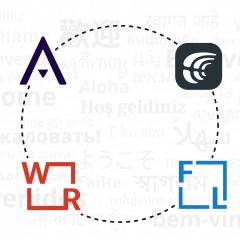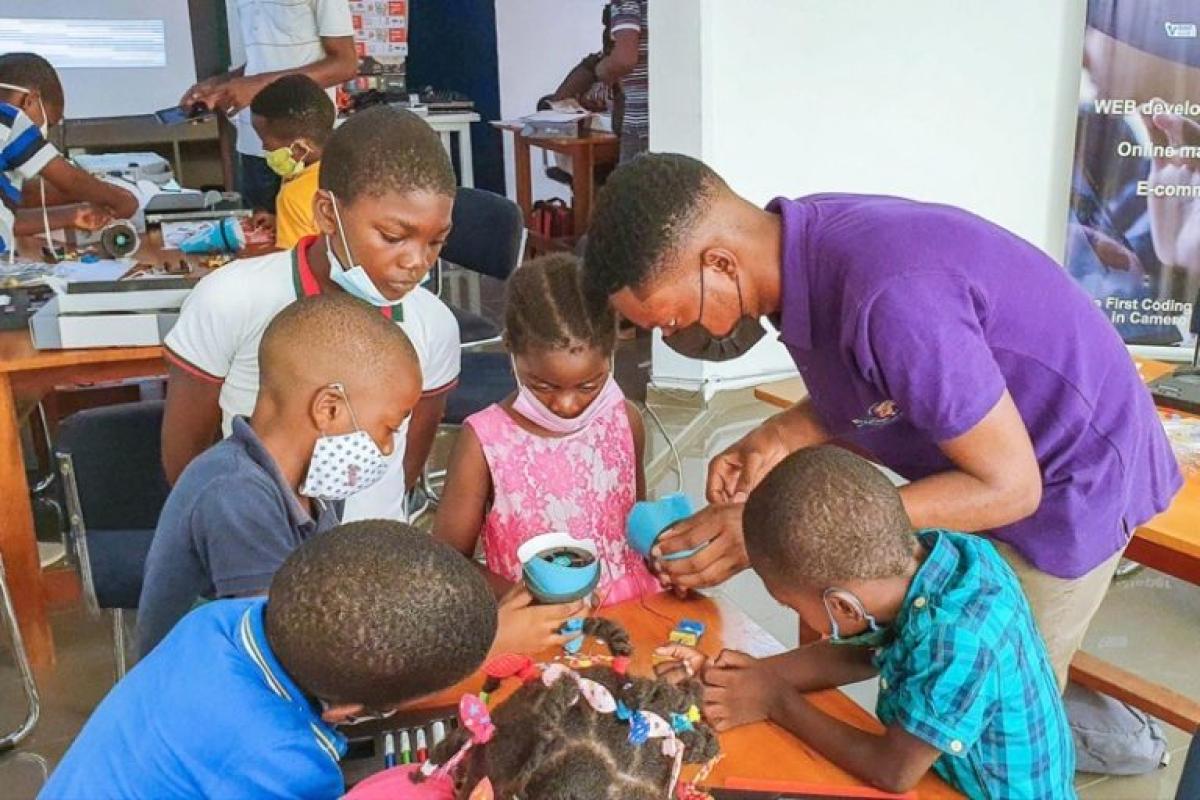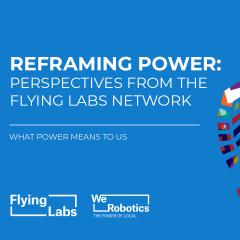
Learning Beyond the Classroom: Drones in STEM Education for the Next Generation
July 11th, 2023

Written by Ciku Kimeria
Looking back at my primary and high school years in the public school system in Nairobi, Kenya, I realize that much of the content I learned is no longer relevant. I learned how to draw and name the parts of a cockroach, the kidney, and a desktop computer and explain all their functions. We did calculations using logarithmic tables, and in navigation courses, I learned to calculate where a ship moving from point A to point B would end up if the wind of a certain velocity blew it off course.
The traveler in me enjoyed the navigation courses as I could picture myself one day on a ship bound for New Caledonia, picking up the radiotelephone and saying, “Mayday! Mayday! Mayday! This is Captain K. Our ship was heading due North at 40km/h but has been blown off course by wind blowing from 30° south-west at 5 km/h. By my calculations, our current speed is now 20km/h, and we will arrive at the North of the island in five days. Can you please send supplies? I repeat, please send supplies.”
This scenario never happened because satellite information, google maps, and internet access have made such skills redundant. Also, when I went to the US for my undergraduate studies, calculators during exams and open-book exams made my memorization and impressive kidney and cockroach drawing skills archaic. Google and Wikipedia also changed how the world thinks about the static nature of knowledge.
This change happened quite rapidly, and for the younger generations, change in what one needs to learn to excel in future jobs will be at a lightning pace. For these generations, what is important isn’t actual content memorization and learning about the world precisely as it is, but instead being prepared for a world where the primary skills needed are problem-solving, data analysis, creativity, an ability to adapt to change and a willingness to keep experimenting, learning and growing. They need to learn about how to think rather than the rigid paradigm of what to know.

Today, data is already considered the new oil, and those who can obtain, analyze, understand, and use it for decision-making are at a great advantage. This is why starting STEM learning early in life is a great way to acquire these skills. Drones allow for this to happen in a fun and engaging way, which is why the majority of Flying Labs implement STEM programs and WeRobotics supports them with facilitating programs, partnerships, collaborations and more. From our experience, we have seen that:
Drones are a great hands-on, practical approach to teaching and learning STEM.
When using drones for data collection, children and youth gain useful skills from every part of the process. This starts with computational thinking as they try to understand what the problem is that they are trying to solve and the best approaches; choosing the right software or sometimes coding; planning the flight; testing out the equipment and understanding what role each part plays; finding a suitable area to fly the drone understanding what role weather elements such as wind play; starts and stops as they try to take off; troubleshooting; spatial visualization to understand where to fly to get the right aerial views; taking off, hovering, rotating and other techniques; and finally data collection, processing, and analysis.
Drone technology is a valuable teaching tool for engaging students in STEM education, offering a hands-on, practical approach to learning, allowing them to apply STEM principles in a real-world context.
— Dr. Renee Welch, Co-Pilot, WeRobotics
Drones are a versatile tool for introducing youth to STEM and can be integrated across various disciplines ...
...while improving their computational thinking and spatial visualization skills. With drones, students can collect, process, and analyze data to make informed decisions. They can also program and modify it to complete various tasks. Drones provide a unique platform for integrating various STEM subjects. Students can explore concepts from multiple fields simultaneously, gaining a holistic understanding of how these subjects relate to each other and their daily lives. These include:
- Science — Using imagery or video data to make analyses, models, and predictions for urban planning, climate change, environmental conservation, precision agriculture, etc. This can include various fields of study such as Geospatial Information Systems, Environmental Science Policy and Management, Marine Sciences, Geography, etc.
- Technology — The practical use of technology to improve life. This includes but is not limited to using drones in humanitarian crises (flooding in South Africa), climate action, agriculture, urban development, cultural heritage conservation, and even counting animals in the highlands of Peru.
- Engineering — This can include data engineering and analysis to improve AI tools and current drone hardware for efficient operations. This covers fields of study such as aeronautical, electronics and electrical, mechanical, and robotics engineering.
- Mathematics — Improving how drones work and optimizing their performance. Particularly useful for autonomous applications such as mapping missions, obstacle avoidance, or landing a helicopter on Mars.
Drones can be used for knowledge acquisition.
Students can learn about various drone operation technologies, including aerodynamics, aviation, programming, and data analysis, by working with drones. Drones serve as a tangible tool that encourages exploration and problem-solving.
Data collected from drones is also great for teaching STEM.
While drones as a tool are very engaging for children and youth and get them motivated, the data collected using drones can also be analyzed and used to teach STEM. The aerial view provided by drone data enables youth to study a phenomenon while exploring its relationship with its environment, people, and time.
They are inexpensive and accessible, making them applicable to educational settings.
Affordable drone technology makes it accessible to a wide range of students. This affordability allows for the incorporation of drones into educational settings without significant financial barriers.

A wide range of different skills can be developed using drones.
Engaging with drones promotes the development of essential skills such as imagination, creativity, project management, and technology proficiency. Students learn to think critically, work collaboratively, and adapt to challenges, which are vital skills for their future careers.
Working with drones for STEM is a valuable tool for work readiness.
By expanding STEM youth programs, there is a focus on preparing the workforce of the future. Through developing technical skills, critical thinking abilities, and a passion for STEM, these programs equip students with the tools they need for successful careers in emerging fields.
They can foster the creation of a local STEM ecosystem.
Integrating drones into community programs implemented by local nonprofits and associated organizations creates a local STEM ecosystem. This approach leverages community resources and expertise, fostering sustainability and long-term impact.
STEM engagement can happen spontaneously during projects and can be used to educate entire communities.
Drones take out the rigidity of a classroom experience and can therefore be used to engage people, especially in marginalized communities in Zambia, Cameroon, Panama, and beyond, who might not be exposed to STEM in a formal experience or might believe that they are not skilled at it. Queen Ndlovu, managing director of South Africa Flying Labs, says, "For us, it is natural that STEM engagement becomes part of the package offering when engaging with communities for projects. It starts with the consultation process for the project with the community and we are very intentional about including youth. We ask community leaders to extend the invitation to youth to be part of the consultation process. We set time aside during the project to expose youth to the jobs of the future and career prospects for drones, data and more"

Drones are inclusive and equitable and can help get girls engaged in STEM.
Globally, STEM fields tend to be very male-dominated, meaning there are only so many female role models to look up to for young girls. In 2019, women only accounted for 13% of the drone industry’s workforce. It is much worse in several other STEM fields. At a very young age, the message that girls absorb from such norms is that “This is not for me.” As drones are nascent, there is an opportunity to shake up this narrative with women role models in the Flying Labs network inspiring young girls to explore technical fields. With programs such as Fly Like a Girl and close to one-third of women either as the lead coordinator or active member of 40+ Flying Labs, girls will see that this is a field for them too. Drones can boost confidence in youth and disadvantaged communities, especially girls.
Drone-based STEM programs can promote gender equity and inclusivity, focusing on underrepresented areas and explicitly targeting girls. These programs create a more inclusive STEM ecosystem by providing equal opportunities and encouraging participation from diverse backgrounds.
WeRobotics and a first cohort of four Flying Labs are working on a new multi-year STEM Sheroes program. The program draws on learnings from previous multi-year, multi-Flying Labs projects such as "Fly for the Future" supported by Fondation Botnar. It focuses on continuity and deep engagement with children and youth of all ages over an extended period. The program aims to provide context-specific, locally-led STEM programs focusing on girls and women. STEM Sheroes’ long-term approach allows for a comprehensive learning experience and cultivating skills and interests.
Integrating drones into STEM education offers exciting opportunities for children and youth to engage with STEM subjects, develop essential skills, and explore potential career paths. By leveraging drone technology intelligently, the programs created by Flying Labs and WeRobotics can enhance learning and empower youth to become active contributors in the STEM fields.
Ciku Kimeria is sharing her storytelling talent with WeRobotics to make the many stories in our minds and hearts come alive from a different perspective. Tell these stories will contribute to changing mindsets and inspiring local talent on how drones and their applications in the hands of local experts create a positive social impact. Ciku is a Kenyan storyteller whose work spans storytelling for development agencies, journalistic writing, editing for different media houses, travel writing, and mystery novels.
Category(s):
Location(s):
Recent Articles

